 Watershed: Palouse Basin
Watershed: Palouse Basin
Stream Name: Deep Creek
Date Established: 05/15/2006
Project Status: Complete, maintenance and monitoring ongoing
Overview
Funding Agency: Department of Environmental Quality
Project Location: Latitude: 46.9352 N Longitude: 116.9346 W
Target Pollutants:
- Sediment
- Nutrients
- Temperature
- Bacteria
Waterbody Type(s): Intermittent
Hydrologic Unit Code: 17060108
Description
To decrease non-point source pollutant loads with the Deep Creek Stabilization Project, the Palouse-Clearwater Environmental Institute (PCEI) has completed stabilizing 2,782 linear feet of stream bank on Deep Creek, a tributary of the Palouse River in Latah County, Idaho. This project was cooperative in nature involving private landowners, the Natural Resource Conservation Service, university professors and students, local students, community organizations and volunteers.PCEI focused restoration activities along the segment of Deep Creek that bisects the property of Buck Espy, a long-time resident of Potlatch, Idaho. The goal of the project was to provide direct water quality improvements and benefit the community through hands on volunteer activities and education programs. Due to the intensive impacts from agriculture, ranching, and residential development in the watershed, sediment and temperature reduction were the primary targeted pollutants for the project based on the lower Deep Creek watershed priorities and goals of the Palouse Tributaries TMDL and the Palouse River Tributaries Watershed Advisory Group. Utilizing local resources and community volunteerism has been a cost effective way to maximize the impacts of US EPA 319 Nonpoint Source Funds.The stabilization and revegetation of 2,782 feet of stream bank will reduce in-stream erosion. Bank stabilization techniques included excavation and re-sloping of the stream bank and installation of coir log and erosion control fabric. The 43,789 square feet variable riparian buffer was planted with over 1,400 native woody species. The riparian buffer will act as a filter reducing overland sediment flows, while filtering nutrients and bacteria generated from upland land use practices. Restoration also included the construction of a riparian fence and hardened rock crossing to allow livestock and tractor access to both sides of the creek. Off stream watering was also installed to help reduce impacts of the livestock on Deep Creek. Now that the stream is fenced off from the livestock, weed control is a major issue. PCEI is working with the landowner to develop a riparian, grazing rotation to help in the weed control efforts.
Previous Conditions
The project is located in the lower Deep Creek watershed on private property and is considered a critical target area for sediment reduction and temperature due to intensive impacts from agriculture, ranching and residential development in the watershed. Currently, Deep Creek is an intermittent stream characterized by flashy later winter and spring runoff flows and minimal to no flow from late July through October. Sediment, temperature, nutrients, and bacteria are impairing beneficial uses in Deep Creek.On the project site prior to restoration and fencing activities, livestock had full access, year-round to the riparian area and the creek, causing soil compaction, the removal of most woody vegetation and the input of manure directly to the creek. Because the stream is intermittent, during low flows of summer, the livestock had full access to the stream channel and contributed to the altering of the low-flow channel. Livestock were helping to control the many invasive weeds that can be found on the site.
Photo History:
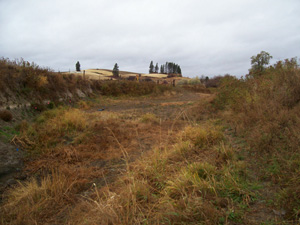 Upstream Before Restoration (Summer 2006): Prior to restoration activities the stream banks were steep and eroding with minimal native, woody vegetation. Livestock grazing in the channel contributed to soil compaction and a lack of a defined low-flow channel.
Upstream Before Restoration (Summer 2006): Prior to restoration activities the stream banks were steep and eroding with minimal native, woody vegetation. Livestock grazing in the channel contributed to soil compaction and a lack of a defined low-flow channel.
 Bankfull Water Levels (June 2006): Sediment levels in the stream are extremely high. The aim of the project is to minimize bank erosion through re-sloping and re-vegetating with native grasses, shrubs, and trees. The plants will also help to shade the stream and decrease elevated temperatures.
Bankfull Water Levels (June 2006): Sediment levels in the stream are extremely high. The aim of the project is to minimize bank erosion through re-sloping and re-vegetating with native grasses, shrubs, and trees. The plants will also help to shade the stream and decrease elevated temperatures.
 Pre-Construction Cattle Crossing (October 2006): During restoration activities a hardened rock crossing with be constructed in order to reduce impacts of livestock grazing in the riparian area and in the stream channel. The crossing will allow livestock and tractor access on both sides of Deep Creek, which is necessary for the landowner’s livestock operation.
Pre-Construction Cattle Crossing (October 2006): During restoration activities a hardened rock crossing with be constructed in order to reduce impacts of livestock grazing in the riparian area and in the stream channel. The crossing will allow livestock and tractor access on both sides of Deep Creek, which is necessary for the landowner’s livestock operation.
 Upstream from Crossing (October 2006): Looking upstream from the livestock crossing area, the natural stream meanders are evident, as well as some remnants of the low flow channel.
Upstream from Crossing (October 2006): Looking upstream from the livestock crossing area, the natural stream meanders are evident, as well as some remnants of the low flow channel.
 Upper Reach Project Boundary (October 2006): Many natural pointbars that were left untouched during excavation provide suitable planting conditions for cottonwood and willow. The goal of the project is to re-slope areas of the stream bank that are severely eroding and nearly vertical.
Upper Reach Project Boundary (October 2006): Many natural pointbars that were left untouched during excavation provide suitable planting conditions for cottonwood and willow. The goal of the project is to re-slope areas of the stream bank that are severely eroding and nearly vertical.
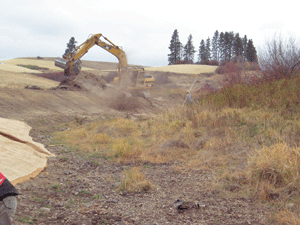 Construction Underway (Fall 2006): The construction phase of the project was completed in late October of 2006. The PCEI watersheds crew, AmeriCorps members, and multiple community and student volunteers helped to install erosion control fabric on the banks.
Construction Underway (Fall 2006): The construction phase of the project was completed in late October of 2006. The PCEI watersheds crew, AmeriCorps members, and multiple community and student volunteers helped to install erosion control fabric on the banks.
 Washington State University Volunteers Get Their Hands Dirty (October 2006): On October 17, 2006, 15 WSU Landscape Architecture Students joined the Watersheds Crew in installing erosion control fabric on the freshly excavated stream banks. Prior to the installation of the fabric the banks are seeded with a native mix of grasses.
Washington State University Volunteers Get Their Hands Dirty (October 2006): On October 17, 2006, 15 WSU Landscape Architecture Students joined the Watersheds Crew in installing erosion control fabric on the freshly excavated stream banks. Prior to the installation of the fabric the banks are seeded with a native mix of grasses.
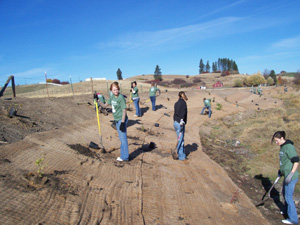 Volunteer Planting (October 2006): PCEI volunteers plant the newly excavated stream banks with native trees and shrubs from the PCEI Learning Nursery.
Volunteer Planting (October 2006): PCEI volunteers plant the newly excavated stream banks with native trees and shrubs from the PCEI Learning Nursery.
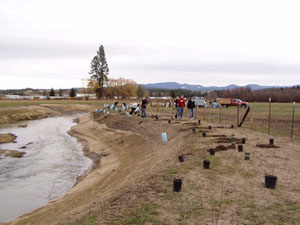 Spring Planting Event (Spring 2007): On March 24, 2007 24 volunteers helped plant 400 trees and shrubs, rake grass seed, and fix the log drop. Volunteers included various AmeriCorps volunteers, fraternities and sororities from the University of Idaho, and local community members.
Spring Planting Event (Spring 2007): On March 24, 2007 24 volunteers helped plant 400 trees and shrubs, rake grass seed, and fix the log drop. Volunteers included various AmeriCorps volunteers, fraternities and sororities from the University of Idaho, and local community members.
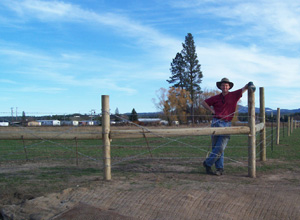 Spring Fence Building (Spring 2007): From late March into early April 2007, the Watersheds Team, along with the help of the landowner, and many volunteers, built a fence on the east side of Deep Creek. This fence will allow the cattle to continue to graze, while protecting the creek.
Spring Fence Building (Spring 2007): From late March into early April 2007, the Watersheds Team, along with the help of the landowner, and many volunteers, built a fence on the east side of Deep Creek. This fence will allow the cattle to continue to graze, while protecting the creek.
 Planting Willow and Cottonwood Poles (April 2007): On April 6, 2007 the Watersheds Team planted willow and cottonwood poles on the east stream bank. These poles were planted just above the water table and should send down deep roots that will help stabilize the banks.
Planting Willow and Cottonwood Poles (April 2007): On April 6, 2007 the Watersheds Team planted willow and cottonwood poles on the east stream bank. These poles were planted just above the water table and should send down deep roots that will help stabilize the banks.
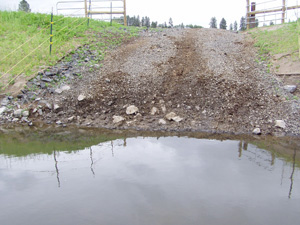 Cattle Crossing Complete (May 2007): PCEI completes the cattle crossing and now the livestock have access to both sides of the creek, but only a small crossing through the creek with help reduce impacts caused by livestock.
Cattle Crossing Complete (May 2007): PCEI completes the cattle crossing and now the livestock have access to both sides of the creek, but only a small crossing through the creek with help reduce impacts caused by livestock.
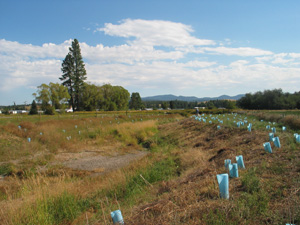 Summer Weeding and Watering (Summer 2007): The summer at Deep Creek has consisted of keeping plants watered, happy, and alive and preventing invasive plants from producing viable seed.
Summer Weeding and Watering (Summer 2007): The summer at Deep Creek has consisted of keeping plants watered, happy, and alive and preventing invasive plants from producing viable seed.